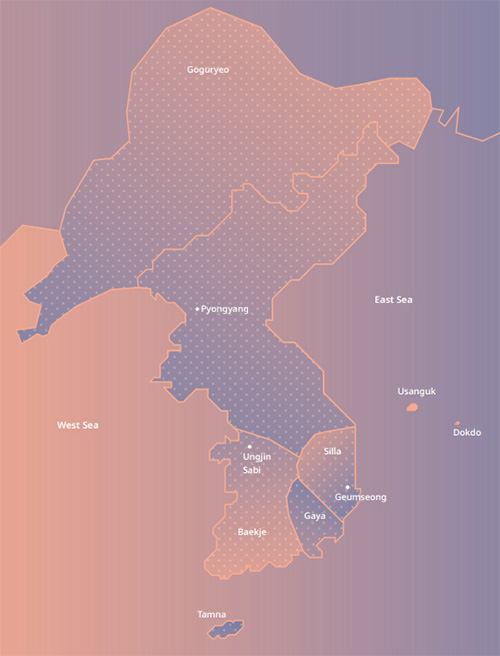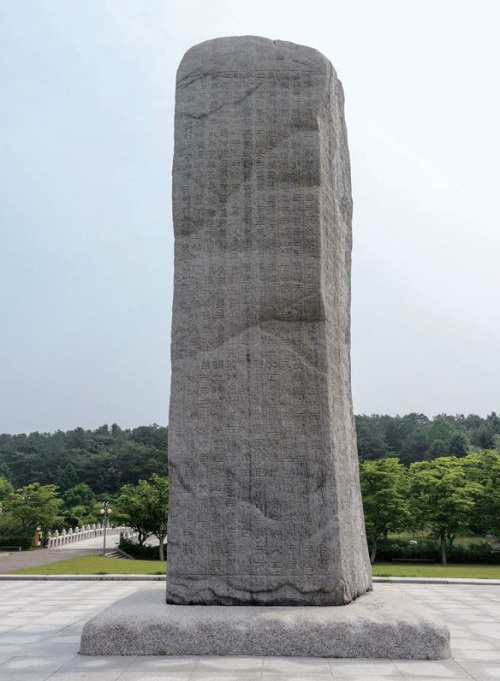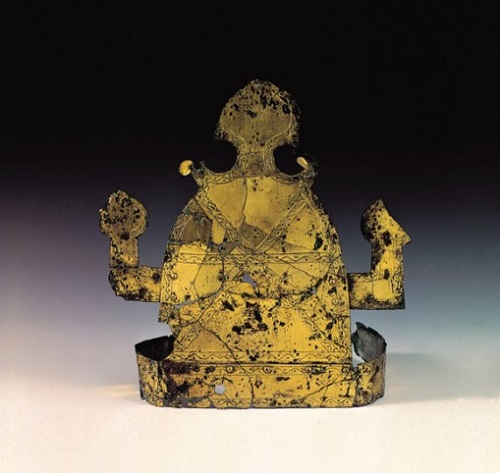O Korei
Buyeo fell apart during the establishment of the regional confederation, but the factions that founded Goguryeo and Baekje took pride in their status as the inheritors of Buyeo. Samguk sagi (History of the Three Kingdoms) states that Gojumong, who founded Goguryeo in 37 B.C.E., was originally from Buyeo. Goguryeo prospered greatly through victorious wars in areas close to Baekdusan Mountain and along the Amnokgang (Yalu) River. Right after its foundation, Goguryeo conquered a number of small states in the area and moved its capital to Gungnaeseong (Tonggu) near the Amnokgang River. Through many wars, it drove away the factions loyal to the Han dynasty and expanded its territory as far as Liaodong in the west and to the northeast of the Korean Peninsula. It became a powerful state, exerting control over Manchuria and the northern part of the Korean Peninsula.
There were also a number of small states, such as Okjeo and Dongye, in present-day Hamgyeong-do and the northern parts of Gangwon-do along the east coast of the Korean Peninsula. Located in outlying areas, they did not develop very rapidly. Okjeo offered tribute such as salt and fish to Goguryeo. Dongye held a sacrificial rite for heaven called Mucheon in October to build a spirit of collaboration by singing and dancing together. Its specialties included dangung (an archery bow) and gwahama (a horse small enough to pass unhindered beneath fruit trees). These two states were also incorporated into Goguryeo.
The area south of Gojoseon was occupied by a large group of small states including Mahan, Jinhan, and Byeonhan. Mahan was a confederacy of 54 small states (composed of 100,000 households in total) located in present-day Gyeonggi-do, Chungcheong-do, and Jeolla-do. Byeonhan was located in present-day Gimhae and Masan while Jinhan was located in present-day Daegu and Gyeongju. Each of the latter two was composed of 40,000 – 50,000 households. The three ministates were collectively known as Samhan (Three Han States). The people of Samhan held rites of sacrifice for heaven in May and October. On such occasions, they gathered together to enjoy liquor, food, singing and dancing.
Along with the spread of Iron Age culture and the development of farming skills, powerful states such as Goguryeo, Baekje and Silla gradually were established in Manchuria and on the Korean Peninsula.
Goguryeo was the first of the three Kingdoms to firmly establish itself as a sovereign country. It started expanding its territory in the late 1st century and strengthened a kingcentered ruling system by the late 2nd century. By the early 4th century, King Micheon of Goguryeo had driven away factions loyal to the Han dynasty from the Korean Peninsula.

The Three Kingdoms and Gaya (5th Century CE)
In 372 (the 2nd year of King Sosurim’s reign), Goguryeo adopted Buddhism and promulgated a code of law in an effort to establish a proper governing system. It also established Taehak, a Confucian educational institute. King Gwanggaeto the Great, drove away the Khitan, Sushen, and Dongbuyeo and expanded his territory into Manchuria. He also captured many of Baekje’s fortresses in the south and helped Silla overcome a crisis by driving away Wako invaders.
Baekje was established in 18 B.C.E. jointly by the people who lived along the Hangang River, people originating from Buyeo and Goguryeo, and migrants from elsewhere. By the mid-3rd century, during the reign of King Goi, Baekje had seized complete control over the areas along the Hangang River and established a solid system of political governance by accommodating the advanced culture of China. By the mid-4th century, King Geunchogo occupied Mahan and expanded the territory as far as the south coast of present-day Jeollanamdo. Along the northern border, Baekje confronted Goguryeo in a bid to take control of present-day Hwanghae-do. It also exerted control over Gaya in the south. At that time, Baekje’s territory included present-day Gyeonggi-do, Chungcheongdo, Jeolla-do, the middle reaches of the Nakdonggang River, Gangwon-do, and Hwanghae-do.

Stele for Great King Gwanggaeto (Goguryeo, 5th Century)
King Gwanggaeto the Great, the 19th king of Goguryeo, expanded the territory of his Kingdom into Manchuria and the Maritime Provinces of Siberia. In 414, his son King Jangsu set up a stele (6.39 m high, 37 tons) in present-day Ji’an, Jilin province, China to commemorate his father’s great achievements. The inscription, comprising 1,775 characters, explains how Goguryeo was founded and how it expanded its territory.
Silla originated in Saroguk, one of the mini states of Jinhan. It was established as a kingdom in 57 B.C.E. by the natives of present-day Gyeongju and people from other regions. Those with the family names Park, Seok, and Kim acceded to the throne in turn. By around the 4th century, the Kingdom occupied most of the areas east of the Nakdonggang River. During the reign of King Naemul, Silla allowed Goguryeo troops to remain within the Kingdom to help drive away Wako invaders. It also adopted Chinese culture and civilization through Goguryeo.

Gold Crown of Gaya (Gaya, 6th Century)
This crown was unearthed in Goryeong, Gyeongsangbuk-do. It features upright decorations and curved jade pendants.

A Painting of Hunting Scenes in the Tomb of the Dancers (Goguryeo, 5th Century)
Dynamic hunting activities of the people of Goguryeo
In Byeonhan, located along the lower reaches of the Nakdonggang River, the Gaya Confederation emerged, with Geumgwan Gaya playing a leading role. The confederation developed an Iron Age culture and exerted considerable influence on areas along the Nakdonggang River. Gaya states started rice farming early on, thus its farming culture flourishing. It also traded actively with Wa (Japan) and Lelang, taking advantage of an abundance of iron and convenient sea routes.

Great Gilt-bronze Incense Burner of Baekje (6th Century)
This precious object has helped researchers broaden their understanding of the production skills, handicrafts, artistic culture, religion, and philosophy of Baekje.
